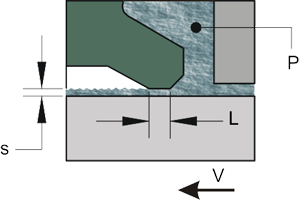The demand of seals for hydraulic cylinders is to prevent the flow of fluid across two surfaces in relative movement and to maintain a high level of sealing performance during their service life under the operating conditions for which they have been chosen.
During the movement a drag flow develops through the sliding motion and, as consequence of a hydrodynamic growth of pressure, the seal is lifted off the sliding surface and a thin film of fluid remains between the seal and the sliding surface. The thickness of this film of fluid is regulated by the following formula:
s = K ∙ √(µVL/P)
where
- s = thickness of the film of fluid

- K = coefficient (≈ 2,3)
- µ = fluid viscosity
- V = speed
- L = length of the surfaces in relative movement
- P = pressure
Since the thickness of this film is the amount of fluid that goes through the seal during the movement, it can be considered within certain limits as something equivalent to a leakage.


